As an athlete, an abundant amount of time is focused on training, optimizing various skill development, gaining strength, improving power, and building resilience. As a student-athlete, class attendance is mandatory, requiring a lengthy amount of time sitting. The time spent in a classroom combats the healthy movements performed in sport. Unfortunately, running around for a couple of hours during practices does not negate the 6-8 hours athletes are staying seated during class. However, there are plenty of quick “tricks” student athletes can perform throughout their day to improve posture, mobility, and core strength. Not only does moving throughout the day provide physical benefits, but it can aid in better concentration, mood, and productivity. The exercises and mobility work detailed in this article are not time consuming, although it is crucial to be consistent with these movements in order to see improvements.
Think of prolonged sitting as an endurance event. Our muscles work to keep the body sitting up nice and straight, but naturally as we get tired, we start to slouch. Our shoulders start to round forward, the head drifts downward, and our bodies will begin to slouch. This is the complete opposite of what we’d consider optimal posture for an athlete. With years of this positioning, one may start to notice the inability to have full range of motion in the shoulders and spine, and reduced strength in the core and legs. In addition, chronic prolonged sitting is a high predictor of low back pain. The good news? These issues can be minimized and even reversed by incorporating simple movement patterns throughout the school day.
These exercises are not given with the intent to get in an intense workout during the day, but rather should be seen as restorative, in order to optimize the student athlete’s movement as the day goes on. The human nervous system that controls our muscles gets sleepy and cannot work as well, when individuals are seated for a period of time. Another goal of these modalities is to awaken the nervous system just enough to fire again without putting stress on the body. It is helpful to think of these exercises as a wake up call to the body. Incorporating these movements and being mindful of not sitting too long can also work to build healthy habits and routines. Whether or not you’re physically active in your career after school, by utilizing these movements throughout the day, it will hopefully reduce the risk of other health complications and postural limitations caused by a more sedentary lifestyle.
Below are the top exercises to improve mobility during the school day, as well as helping to keep your muscles awake and support your body. A general rule of thumb for all of these exercises is never push through pain. Pain is a warning sign that something is not quite right. Do not ignore this yellow flag given it could turn into a bigger problem causing more time away from activities. Try to readjust your positioning to see if the pain subsides, but if it does not, please let your parent or coach know so they can address the concern.
Plank on Forearms: Hold for 30 seconds, 2x
How: Elbows bent, forearms on the ground, shoulder width apart, toes pointed down towards the ground, push forearms into the floor as you elevate the hips off the ground. You want to slightly round your shoulders so that you’re not just hanging on them (i.e. your shoulder blades shouldn’t be visible in this position), we want them engaged working those shoulder blade muscles for stability along with squeezing the glutes to help engage the core.
Do not: Arch your back, hang on your shoulders, keep going if you cannot hold proper form
Do: Breathe, keep everything engaged in this position
Where should you feel it? Core, slightly in the shoulders, slightly in the quads
Where you shouldn’t feel it? Lower back
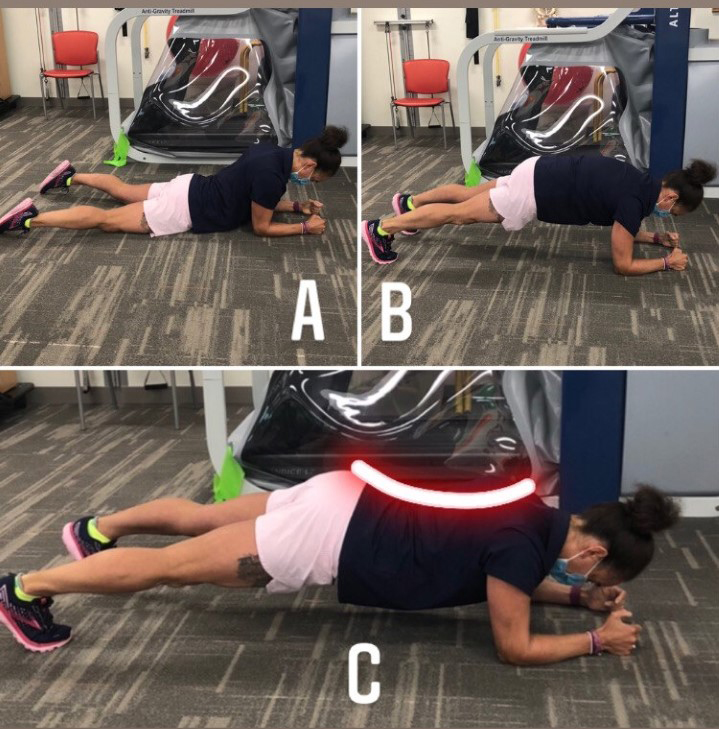
A. Starting Position - Lie on your stomach, palms on the floor and shoulder width apart, toes pointed down
B. Moving Position - Shoulders rounded, hips tucked underneath, core engaged, lift hips off ground
C. Wrong: Shoulders dropped down, hips dipped down
Single Leg Deadlifts: 1x10 each leg
How: Standing on one leg, knee slightly bent, maintain that same angle of knee bend throughout the whole movement as you reach your opposite hand down towards the floor by hinging at your hips. Stop when your back is parallel to the floor, then push through your foot to raise back up and tighten the glutes at the top when you’re all the way back up
Do not: Rotate your hips (You can place a foam roller behind your stationary leg to ensure you keep your hips level, if they’re not, you’ll knock the foam roller over), do not squat down on the stationary leg, do not round your back
Do: Keep your back straight, hips level, core tight
Where should you feel it? Hamstring (back of the leg) on the standing leg and glutes at the top of the motion
Where you shouldn’t feel it? Lower back
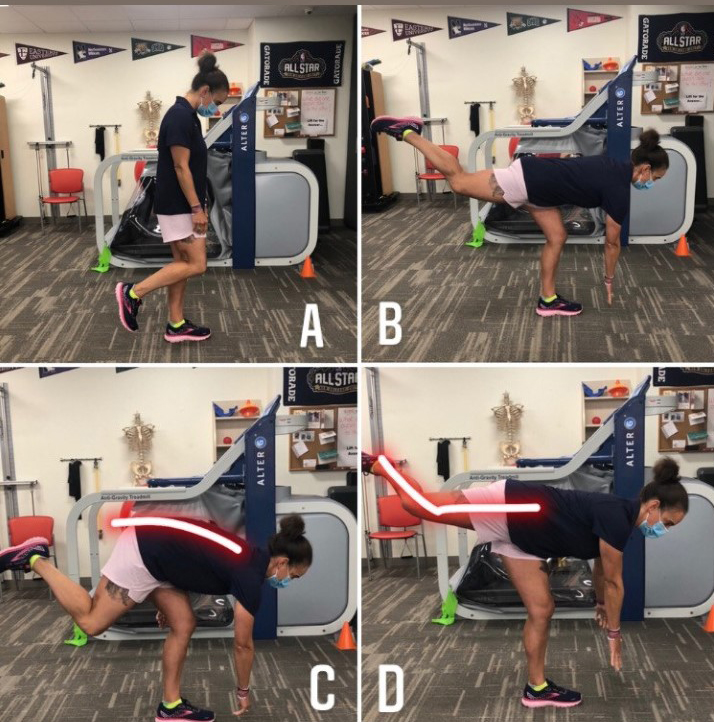
A. Starting Position - Stand on one leg, knee slightly bent
B. Holding Position - Reach opposite hand toward your foot, hips level, back straight, hinge at the hips
C. Wrong: Do not squat, do not round back, do not rotate hips
Squat: 1x10
How: Stand with feet about hip width apart, keeping your core tight and back straight, push your hips back and squat down keeping your knees over your toes, pause at the bottom, then stand back up to the starting position.
Do not: Watch your knees to make sure they do not go too far inward, do not round your shoulders, don’t let your heels come up off the ground
Do: Knees over toes, hips back, weight even on your feet, core tight
Where should you feel it? Core, glutes, quads
Where you shouldn’t feel it? Lower back
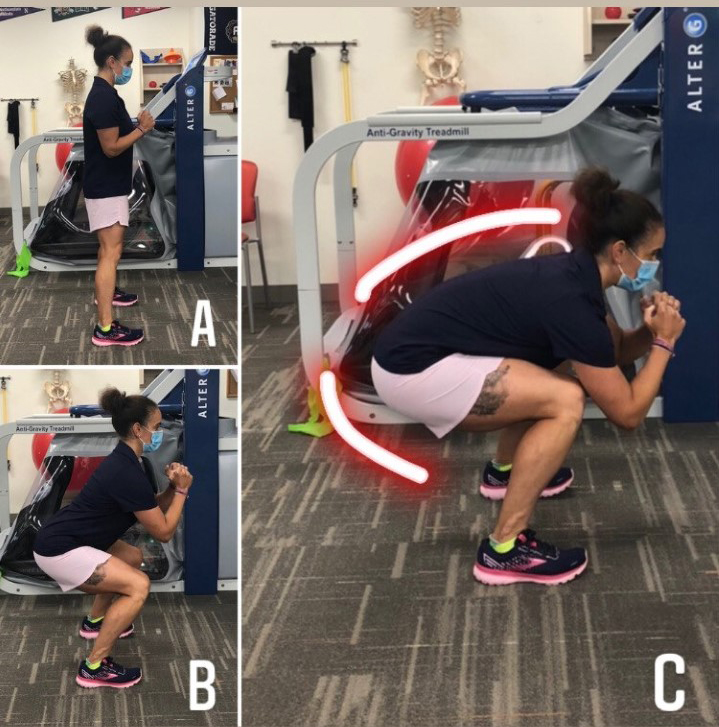
A. Starting Position - Feet about shoulder width apart, back straight
B. Moving Position - Push hips back, bend knees, core tight, keep knees over your toes, back straight/chest up and head forward
C. Wrong: Rounding your back, letting your knees fall inward, not maintaining core tightness
Trunk Rotation Stretch: 1x10 each way
How: Lie on one side, place pillow or foam roller under your top leg, hold that leg down with your bottom hand, turn the opposite way without letting your hips roll back, then return to the starting position
Do not: Let your hips roll back
Do: Keep core tight, breathe
Where should you feel it? The side of the body that is on top, maybe in the front of the
shoulder/arm that’s turning if that’s tight
Where you shouldn’t feel it? This one you may feel in many places which is okay if it doesn’t hurt
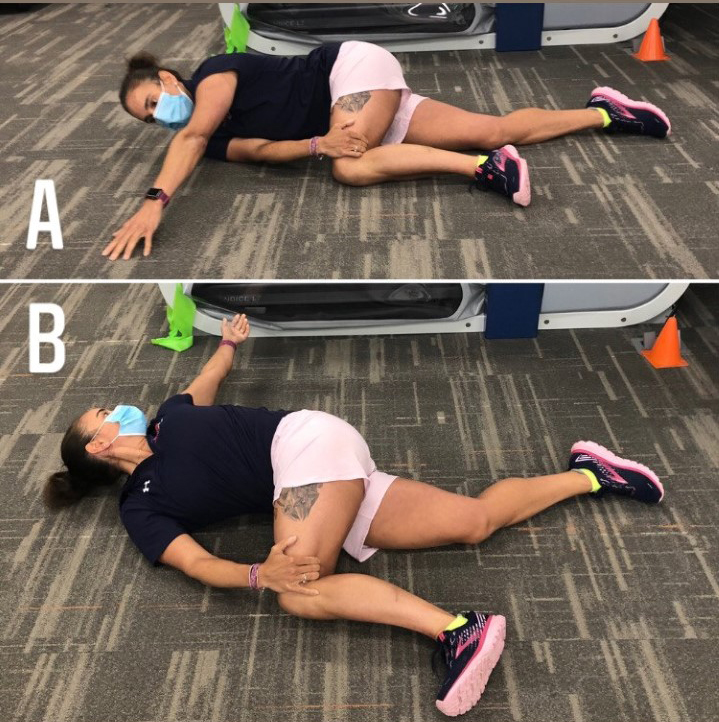
A. Starting position - Lie on your side, top knee bent, bottom leg straight, hold top knee down, keep top arm straight
B. Rotate/turn your body the opposite direction. Follow your eyes with your top hand, do not let hips roll back and breathe
Superman’s: 1x10
How: Lie on your stomach, arms out over your head, legs back, squeeze your glutes and raise your legs up and arms up, hold at the top a few seconds, then go back down
Do not: Arch your back
Do: Keep core tight, breathe
Where should you feel it? Core, upper back/back of the shoulders
Where you shouldn’t feel it? Lower back
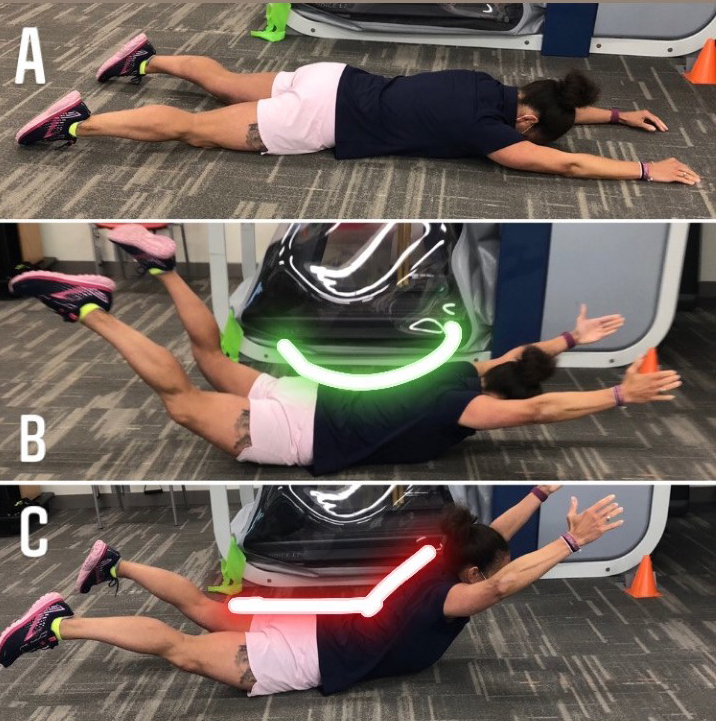
A. Starting position - Lie on your stomach with your arms overhead
B. Holding position - Lift Arms up and legs up, squeeze your glute
Cobras: 20” hold x 3
How: Lie on your stomach, place pillow under your hips, press up and extend your elbows up as you squeeze your glutes, hold 10 seconds then go back down
Do not: Arch your back or push into pain
Do: Keep your glutes tight the whole time, core engaged
Where should you feel it? May feel a stretch in the front of the hips, glutes, core
Where you shouldn’t feel it? Lower back
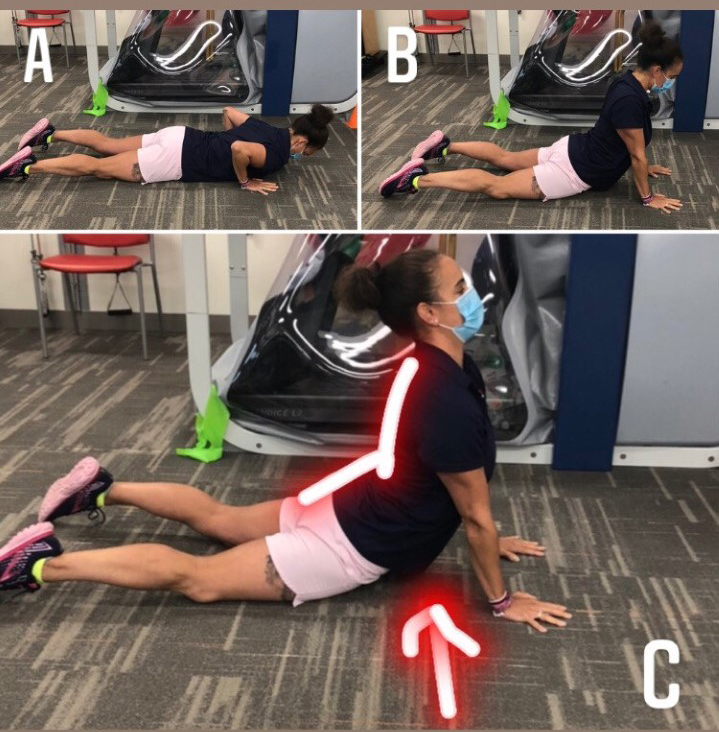
A. Starting position - Lie on your stomach, palms on the floor, elbows bent
B. Moving Position - Push hips into the ground/hands into the floor, straight your elbows and squeeze your glutes
C. Wrong: Not squeezing glutes and arching too much from your back, letting your hips come off the ground
Pull a Parts 2 Way: 1x10 each way
How: 1. Grab a band or a sweatshirt, stand up tall, keep core tight, spread arms outward as you squeeze your shoulder blades back, pause a few seconds and return to the starting position 2. Same as previous, but bring your arms over your head then back to the start position
Do not: Arch your back, push into pain
Do: Engage the core, keep good posture
Alternative if you do not have a band: Just use your arms with no tension and perform the same movement, or, hold a towel and pull it outward for the overhead movement
Where should you feel it? Upper back muscles, shoulders
Where you shouldn’t feel it? Lower back
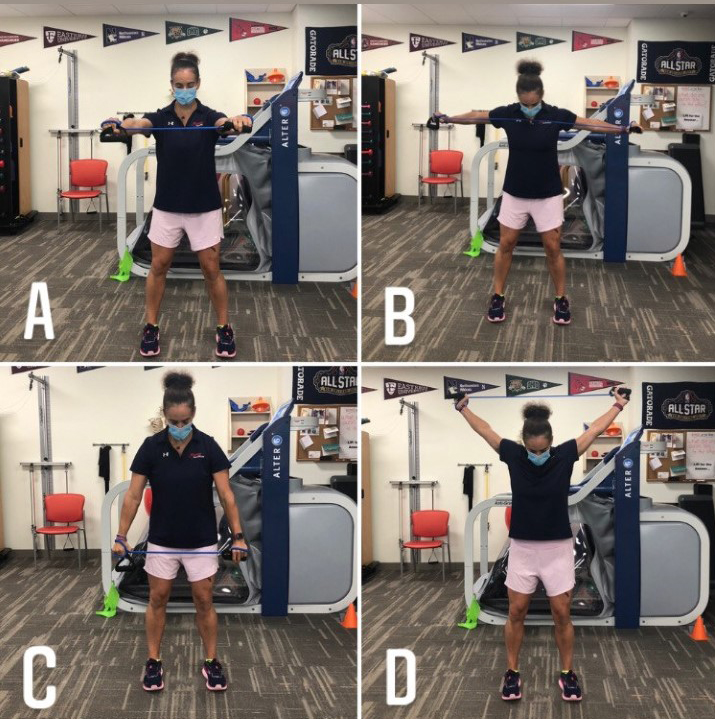
A. Starting Position - Feet hip width apart, core tight, both arms at shoulder height with some tension on the band
B. Moving Position - Keep elbows straight as you extend them back behind you keeping them at shoulder height, squeeze your shoulder blades back as you perform this movement
C. Starting Position - Feet hip width apart, core tight, elbows straight and hands by your pockets
D. Moving Position - Keep tension on the band as you bring the band over your head, squeeze your shoulder blades
Again, it is important to reiterate that these exercises and stretches are not to be done with significant intensity. Each movement should be done purposefully and the student athlete should understand where they should feel the movement to ensure they are not compensating or stressing other areas of their body. Just going through the motions without understanding why the movements are important will not help in creating healthy habits. The student athlete needs to buy into the importance of these exercises to optimize their health and ability to play their sport.
Sometimes the hardest part of incorporating a new routine is just getting started. So, perhaps encouraging athletes to track how often they were able to perform these movements and share that with their coach, parent or trainer to aid in accountability. Move with intention and move well!
Rebecca Schumer, PT, DPT is the Clinic Coordinator & Sports Mentor, Program Specialist & Liaison for Sports Performance and Fitness for MedStar Health.


